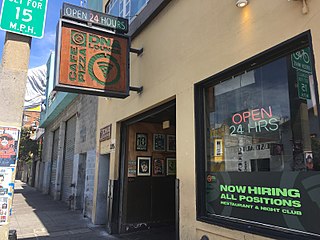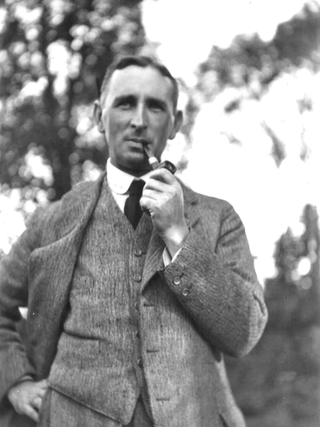
Darlinghurst is an inner-city suburb in the eastern suburbs of Sydney, New South Wales, Australia. Darlinghurst is located immediately east of the Sydney central business district (CBD) and Hyde Park, within the local government area of the City of Sydney. It is often colloquially referred to as "Darlo".

A bar, also known as a saloon, a tavern or tippling house, or sometimes as a pub or club, is a retail business establishment that serves alcoholic beverages, such as beer, wine, liquor, cocktails, and other beverages such as mineral water and soft drinks. Bars often also sell snack foods, such as crisps or peanuts, for consumption on their premises. Some types of bars, such as pubs, may also serve food from a restaurant menu. The term "bar" refers to the countertop where drinks are prepared and served, and by extension to the overall premises.

DNA Lounge is an all-ages nightclub and restaurant/cafe in the SoMa district of San Francisco owned by Jamie Zawinski, a former Netscape programmer and open-source software hacker. The club features DJ dancing, live music, burlesque performances, and occasionally conferences, private parties, and film premieres.

Kings Cross is an inner-eastern locality of Sydney, New South Wales, Australia. It is located approximately 2 kilometres east of the Sydney central business district, in the local government area of the City of Sydney. It is bounded by the suburbs of Potts Point, Elizabeth Bay, Rushcutters Bay and Darlinghurst.

A strip club is a venue where strippers provide adult entertainment, predominantly in the form of striptease or other erotic dances. Strip clubs typically adopt a nightclub or bar style, and can also adopt a theatre or cabaret-style. American-style strip clubs began to appear outside North America after World War II, arriving in Asia in the late 1980s and Europe in 1978, where they competed against the local English and French styles of striptease and erotic performances.

SCEGGS Darlinghurst is an independent Anglican single-sex primary and secondary day and boarding school for girls, located in Darlinghurst, an inner-city, eastern suburb of Sydney, New South Wales, Australia.
Carlotta is the stage name of Carol Byron, also known as Carol Spencer and credited briefly as Carole Lea, a transgender Australian cabaret performer and television personality.

Le Crazy Horse Saloon or Le Crazy Horse de Paris is a Parisian cabaret known for its stage shows performed by nude female dancers and for the diverse range of magic and variety 'turns' between each nude show and the next. Its owners have helped to create related cabaret and burlesque shows in other cities. Unrelated businesses have used the phrase "Crazy Horse" in their names.
RAT Parties were a series of large dance parties held in Sydney, Australia during the 1980s and early 1990s. The Powerhouse Museum said that they "formed a key element of an emerging subculture" that was fashion-aware, gay-friendly, appreciated dance music and open, outrageous celebration. Along with the rise of the Sydney Gay and Lesbian Mardi Gras, the success of RAT Parties marked a groundswell of acceptance of Sydney's gay & lesbian community. RAT parties are credited with introducing the visual performance art of VJing to Australia.

The Bondi Surf Pavilion in Sydney, New South Wales (NSW), Australia, is an outstanding beach cultural icon of Australia, together with the beach, park and surf lifesaving club. The structure is listed on the NSW State Heritage Register 01786 as well as by Waverley Council. The building has also been listed by the Heritage Council. According to the National Trust it "has come to represent the Australian culture of beach bathing and outdoors living".
The Home chain of nightclubs was initially started at the height of popularity of house music. The chain was originally called "Jacobs" until being bought out in 2015. The clubs are notorious for their "anti mobile phones" policy, where phones are confiscated before entrance, and when people breach this rule, a form of "punishment" is implemented. The two clubs at the time were two of the largest nightclubs in their respective countries, and were of a number of dance music enterprises operated by the one company, including various other smaller clubs and the outdoor music festival Homelands.

Tony Briggs is an Aboriginal Australian actor, playwright, screenwriter, and producer. He also is a former track and field athlete. He is best known for creating the stage play The Sapphires, which tells the true story of an Aboriginal singing girl group who toured Vietnam during the war.
The Savoy Hotel on Darlinghurst Road in the Kings Cross area of Sydney, Australia burned down on 25 December 1975 with the loss of 15 lives. It was the deadliest hotel fire in Australia at that time.
Sean Christie is the Chief Executive Officer of Carver Road Capital. Previously, Christie served as the President of Events and Nightlife for MGM Resorts International, as well as the Executive Vice President of Business Development for Wynn Resorts and the Chief Operating Officer and the Vice President of Operations at Wynn Las Vegas. Before that he served as the founder and owner of Las Vegas Nightlife Group and managing partner of Encore Las Vegas Beach Club, Surrender Night Club, and Andrea’s Restaurant at the Wynn Las Vegas.

The Slipper Room is a variety theatre and house of burlesque, comedy and neo-vaudeville, located in the Lower East Side district of Manhattan, New York City.

Cremorne Girls High School, is a former high school located on Murdoch Street in the Sydney suburb of Cremorne, New South Wales, Australia. It was a girls high school operated by the New South Wales Department of Education with students from years 7 to 12. The school was first established in 1927 as Neutral Bay Girls Intermediate High School. However, due to declining enrolments the school was declared surplus to the needs of the department and officially closed in 1987. The school and its heritage-listed buildings are now a satellite campus of Redlands.

The Sydney lockout laws were introduced by the Government of New South Wales from February 2014 to January 2020 in the CBD and Oxford Street with the objective of reducing alcohol-fuelled violence. The legislation required 1.30am lockouts and 3am last drinks at bars, pubs and clubs in the Sydney CBD entertainment precinct. The precinct, defined in regulations, was bounded by Kings Cross, Darlinghurst, Cockle Bay, The Rocks and Haymarket.

Thomas Pollard Sampson was a Tasmanian-born Australian architect active in New South Wales during the first forty years of the 20th century. His work encompassed the styles of the Federation Arts and Crafts and Bungalow through to the Inter-War Styles. In 1912 he designed an octagonal roofed stadium at Rushcutters Bay that seated up to 12,000 spectators. At the time, the Sydney Stadium was said to be "the largest roofed-in structure in the world." In the 1920s and 1930s, as a golfer and member of Concord Golf Club and Pennant Hills Golf Club, he designed the clubhouses at both courses. The buildings of both these well known Sydney clubs are still in use in 2023.
The Hayes Theatre is a 111-seat theatre specialising in music theatre and cabaret in Potts Point, Sydney, Australia. It is named after the Australian performer Nancye Hayes.
Billie Rose Prichard is an Australian actress on stage and screen, and a hip-hop musician. She was nominated for Best Supporting Actress in the 2011 Sydney Theatre Awards.












